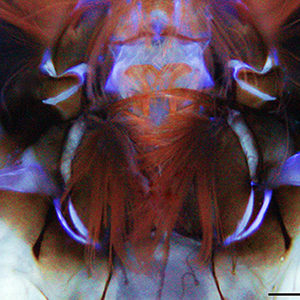Imaging and spectral analysis of autofluorescence patterns in larval head structures of mosquito vectors

Submitted: 14 June 2022
Accepted: 3 August 2022
Published: 20 September 2022
Accepted: 3 August 2022
Abstract Views: 790
PDF: 377
HTML: 43
HTML: 43
Publisher's note
All claims expressed in this article are solely those of the authors and do not necessarily represent those of their affiliated organizations, or those of the publisher, the editors and the reviewers. Any product that may be evaluated in this article or claim that may be made by its manufacturer is not guaranteed or endorsed by the publisher.
All claims expressed in this article are solely those of the authors and do not necessarily represent those of their affiliated organizations, or those of the publisher, the editors and the reviewers. Any product that may be evaluated in this article or claim that may be made by its manufacturer is not guaranteed or endorsed by the publisher.
Similar Articles
- Wenjing Liu, Shanshan Ming, Xiaobing Zhao, Xin Zhu, Yuxiang Gong, Developmental expression of high-mobility group box 1 (HMGB1) in the mouse cochlea , European Journal of Histochemistry: Vol. 67 No. 3 (2023)
- Y Ohishi, S Komiyama, K Wakida, T Uchida, Y Shiba, Immunohistochemical observation of actin filaments in epithelial cells encircling the taste pore cavity of rat fungiform papillae , European Journal of Histochemistry: Vol. 44 No. 4 (2000)
- Marco Biggiogera, Manuela Malatesta, In memoriam of Prof. Stan Fakan , European Journal of Histochemistry: Vol. 67 No. 1 (2023)
- L. Pieri, C. Sassoli, P. Romagnoli, L. Domenici, Use of periodate-lysine-paraformaldehyde for the fixation of multiple antigens in human skin biopsies , European Journal of Histochemistry: Vol. 46 No. 4 (2002)
- D. Michalski, M. Heindl, J. Kacza, F. Laignel, L. Küppers-Tiedt, D. Schneider, J. Grosche, J. Boltze, M. Löhr, C. Hobohm, W. Härtig, Spatio-temporal course of macrophage-like cell accumulation after experimental embolic stroke depending on treatment with tissue plasminogen activator and its combination with hyperbaric oxygenation , European Journal of Histochemistry: Vol. 56 No. 2 (2012)
- A. Porzionato, M. Rucinski, V. Macchi, G. Sarasin, L.K. Malendowicz, R. De Caro, ECRG4 expression in normal rat tissues: expression study and literature review , European Journal of Histochemistry: Vol. 59 No. 2 (2015)
- T. Karaca, Y. Hulya Uz, R. Karabacak, I. Karaboga, S. Demirtas, A. Cagatay Cicek, Effects of hyperthyroidism on expression of vascular endothelial growth factor (VEGF) and apoptosis in fetal adrenal glands , European Journal of Histochemistry: Vol. 59 No. 4 (2015)
- Paolo Flace, Diana Galletta, Antonella Bizzoca, Gianfranco Gennarini, Paolo Livrea, A candidate projective neuron type of the cerebellar cortex: the synarmotic neuron , European Journal of Histochemistry: Vol. 68 No. 2 (2024)
- B Helliot, B Panis, JP Busogoro, S Sobry, Y Poumay, M Raes, R Swennen, P Lepoivre, Immunogold silver staining associated with epi-fluorescence for cucumber mosaic virus localisation on semi-thin sections of banana tissues , European Journal of Histochemistry: Vol. 51 No. 2 (2007)
- M. Di Rosa, M.A. Szychlinska, D. Tibullo, L. Malaguarnera, G. Musumeci, Expression of CHI3L1 and CHIT1 in osteoarthritic rat cartilage model. A morphological study , European Journal of Histochemistry: Vol. 58 No. 3 (2014)
<< < 17 18 19 20 21 22 23 24 25 26 > >>
You may also start an advanced similarity search for this article.

 https://doi.org/10.4081/ejh.2022.3462
https://doi.org/10.4081/ejh.2022.3462











